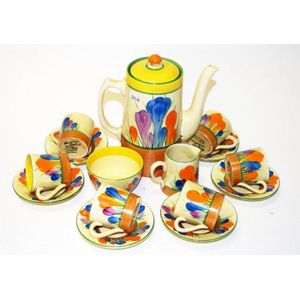
Clarice Cliff Bizarre "Crocus" Coffee Set with Damaged Pieces
Clarice Cliff Bizarre ''Crocus'' coffee set to include coffee pot, six each coffee cans & saucers, cream & sugar bowl. Pot 20 cm high. Nb one cup and one saucer damaged.
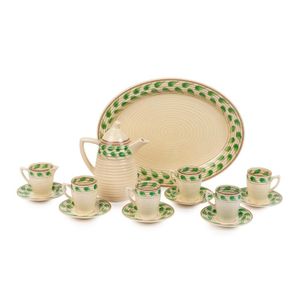
Clarice Cliff 'Christmas Leaves' 14-Piece Coffee Service, 1930s
A Clarice Cliff fourteen piece 'Christmas Leaves' coffee service, 1930s, in pattern 6317 from the Bizarre range, the engine turned service with a beehive shaped coffee pot, five cups with associated saucers, a milk jug and saucer and a large oval platter,…

Hand-painted Clarice Cliff Crocus Tea Set with Repaired Sugar Bowl
A hand painted Clarice Cliff Crocus pattern tea suite comprising coffee pot, jug - large crack, smaller jug, teacup and saucer trio, sugar bowl-repaired to rim

Clarice Cliff Bizarre Demi-Tasse Coffee Set
Clarice Cliff 'Bizarre' demi-tasse coffee set comprising 6x cups, 6x saucers, coffee pot and a milk jug. All signed. C.1930's.
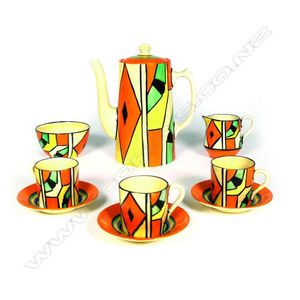
Clarice Cliff Bizarre 'Diamonds' Coffee Set
A c1930 Clarice Cliff Bizarre 'Diamonds' part coffee set, includes 'tankard' form coffee pot with restored lid, sugar, and cream plus three coffee cans and saucers, one can restored, one with crazing. The coffee pot height 19 cm.
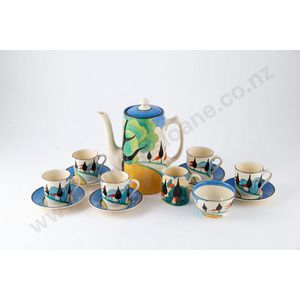
Clarice Cliff Bizarre May Avenue Coffee Set
Exceptionally rare Clarice Cliff Bizarre May Avenue pattern coffee set, comprising, tapering coffee pot, sugar bowl and cream jug, 6 saucers and 5 cylindrical coffee cans, one with rim chip, one base chip, c1933

Peter Pan Coffee Set by Newport Pottery
Newport Pottery Peter Pan pattern coffee set, all with a band of dancing figures on an orange ground, possibly designed by Clarice Cliff, comprising coffee pot, 6 cans and saucers
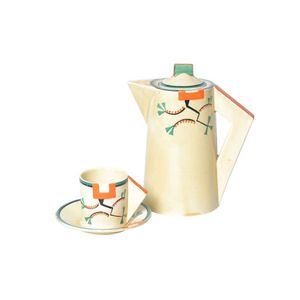
Clarice Cliff Bizarre Ravel Coffee Set
Coffee pot, can & saucer early 20th century, c1928, Newport Pottery, decorated with Clarice Cliff Bizarre Ravel design, black printed factory base stamp

Clarice Cliff Crocus Coffee Pot
Clarice Cliff Bizarre coffee pot 'Crocus' pattern, marked to base, height 19 cm
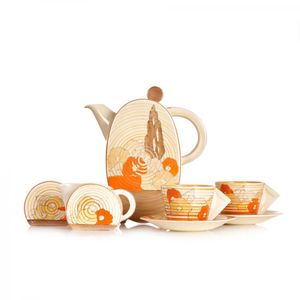
Clarice Cliff Capri Coffee Set, 1935
Seven piece Clarice Cliff Bizarre Capri coffee set c1935, coffee pot, two conical cups & saucers, milk jug and sugar bowl, coffee pot height 20 cm
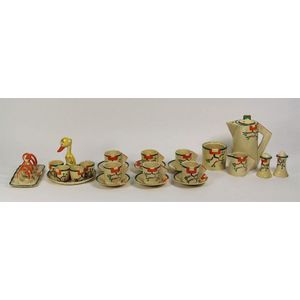
Clarice Cliff Bizarre Ravel Breakfast Set - 23 Pieces
Clarice Cliff Bizarre Ravel part breakfast set, Wilkinson Ltd, to include coffee service for six creamer and a sugar (missing a lid) egg cruet with duck handle, toast rack and salt and pepper (pepper with damage) all in used condition, 23 pieces

Clarice Cliff Fantasque Tankard Coffee Set
Clarice Cliff, Fantasque' Tankard Coffee Pot and Coffee Can with Saucer, c. 1931, Orange House' pattern, printed factory marks to base 'Bizarre Hand Painted Fantasque by Clarice Cliff Newport Pottery England, coffee pot height 19 cm. Provenance: Andrew…
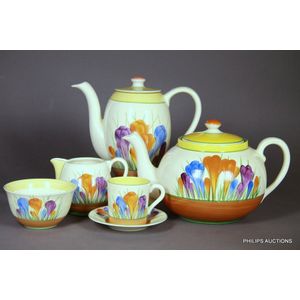
Clarice Cliff 'Autumn Crocus' Tea & Coffee Set
A sixteen piece Clarice Cliff 'Autumn Crocus' tea and coffee service$1928-35 (teapot); and after 1952, comprising a teapot, coffee pot, sugar bowl and six demitasse cups and saucers in blue, orange and purple colours with tan and green borders; one with…

Clarice Cliff Yellow Rose Coffee Pot
A Clarice Cliff Bizarre 'Yellow rose' coffee pot, 1930-35, the striking 'Daffodil' shape pot hand painted with a yellow and orange rose and trailing stems and foliage on a cream ground, with orange, brown, and green stripes to the handle and finial;…

Clarice Cliff Honeyglaze Dinner Set
Extensive Clarice Cliff 'Honeyglaze' dinner set, to include 6 dinner plates, 6 entree plates, 6 side plates, 6 dessert bowls, 6 soup bowls, 6 coffee cups and saucers, coffee pot sugar and creamer, gravy boat and saucer, 3 piece condiment set, dish, lidded…
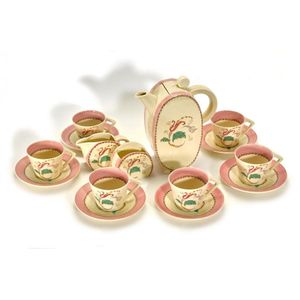
Art Deco Bonjour Coffee Service by Clarice Cliff
Clarice Cliff, A Bonjour porcelain coffee service, circa 1930, modelled in Art Deco geometric forms and comprising: a coffee pot and cover, sugar, milk jug and six coffee cans and saucers, painted with stylised scattering foliage in pinks, orange and…

Clarice Cliff Byzantine Diamond Coffee Pot
A Clarice Cliff Byzantine diamond pattern coffee pot. 7 cm high, 16 cm diameter

Clarice Cliff Tresco Coffee Set, 1935
A Clarice Cliff bizarre orange 'Tresco' coffee set, English, circa 1935 the coffee pot 16 cm high

Eva Crofts' Clarice Cliff Bizarre Tea and Coffee Service
A Clarice Cliff bizarre tea and coffee service designed by Eva Crofts, English, circa 1934 the coffeepot 19 cm high

Clarice Cliff Swirls Coffee Pot
Clarice Cliff 'Bizarre' coffee pot, c. 1929-1930 'Swirls' pattern, stamped 'Registration applied for', printed factory marks to base 'Hand painted Bizarre by Clarice Cliff Newport Pottery England'. Height 21.5 cm

Rare Clarice Cliff Lucerne Art Deco Coffee Set
Rare Clarice Cliff Art Deco coffee set, conical shape, Applique range, Lucerne pattern. Comprising coffee pot, six each cups and saucers, cream and sugar. Excellent original condition. Small glaze loss rim of sugar

Clarice Cliff Bizarre Coffee Set
Clarice Cliff, 'Bizarre' Eva Crofts for Clarice Cliff coffee set, c.1934 'Field Flowers' pattern, 'Bonjour' shape, printed factory marks to base 'Designed by Eva Crofts Produced in Bizarre by Clarice Cliff Wilkinson England', six cups, six saucers, coffee…

Clarice Cliff Fantasque Tankard Coffee Pot
Clarice Cliff, 'Fantasque' tankard coffee pot 'Broth' pattern, printed factory marks to base 'Hand Painted Fantasque by Clarice Cliff Wilkinson England', stamped 'Lawleys Norfolk Pottery in Stoke'. Height 19 cm

Clarice Cliff Goldstone Bizarre Coffee Set
Clarice Cliff, 'Goldstone Bizarre' coffee set 'Goldstone' pattern, printed factory marks to base, 'Hand Painted Goldstone Bizarre by Clarice Cliff Wilkinson Pottery England', six cups, six saucers, coffee pot, creamer, sugar bowl (A/F) (15) Measurements…

Geometric 'Sunburst' Coffee Service by Clarice Cliff
Clarice Cliff, Fifteen piece earthenware coffee service, 'Sunburst' pattern comprising coffee pot, creamer and sugar bowl, having an all over geometric 'Bizarre' colour way

Clarice Cliff Bizarre Solomon's Seal Demi Tasse Set
A Clarice Cliff Bizarre Solomon's seal pattern part demi tasse coffee set, circa 1930, comprising three demi tasse coffee cups and saucers a milk jug and a conical sugar bowl each painted with stylised flowers within mauve blue and green borders black…


 Loading more...
Loading more...